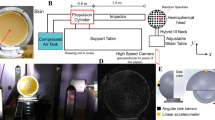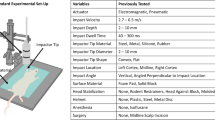Abstract
The WRAIR projectile concussive impact (PCI) model was developed for preclinical study of concussion. It represents a truly non-invasive closed-head injury caused by a blunt impact. The original design, however, has several drawbacks that limit the manipulation of injury parameters. The present study describes engineering advancements made to the PCI injury model including helmet material testing, projectile impact energy/head kinematics and impact location. Material testing indicated that among the tested materials, ‘fiber-glass/carbon’ had the lowest elastic modulus and yield stress for providing an relative high percentage of load transfer from the projectile impact, resulting in significant hippocampal astrocyte activation. Impact energy testing of small projectiles, ranging in shape and size, showed the steel sphere produced the highest impact energy and the most consistent impact characteristics. Additional tests confirmed the steel sphere produced linear and rotational motions on the rat’s head while remaining within a range that meets the criteria for mTBI. Finally, impact location testing results showed that PCI targeted at the temporoparietal surface of the rat head produced the most prominent gait abnormalities. Using the parameters defined above, pilot studies were conducted to provide initial validation of the PCI model demonstrating quantifiable and significant increases in righting reflex recovery time, axonal damage and astrocyte activation following single and multiple concussions.






Similar content being viewed by others
References
Blaszczyk, J. W., and C. Dobrzecka. Effects of unilateral somatosensory cortex lesion upon locomotion in dogs. Acta Neurobiol. Exp. (Wars) 55:133–140, 1995.
Blumbergs, P. C., G. Scott, J. Manavis, H. Wainwright, D. A. Simpson, and A. J. McLean. Staining of amyloid precursor protein to study axonal damage in mild head injury. Lancet 344:1055–1056, 1994.
CDC. Sports-related recurrent brain injuries—United States. MMWR Morb. Mortal. Wkly. Rep. 46:224–227, 1997.
Cernak, I., Z. Wang, J. Jiang, X. Bian, and J. Savic. Ultrastructural and functional characteristics of blast injury-induced neurotrauma. J. Trauma 50:695–706, 2001.
Chen, Z., L. Y. Leung, A. Mountney, Z. Liao, W. Yang, X. C. Lu, J. Dave, Y. Deng-Bryant, G. Wei, K. Schmid, D. A. Shear, and F. C. Tortella. A novel animal model of closed-head concussive-induced mild traumatic brain injury: development, implementation, and characterization. J. Neurotrauma. 29:268–280, 2012.
Cole, J. T., A. Yarnell, W. S. Kean, E. Gold, B. Lewis, M. Ren, D. C. McMullen, D. M. Jacobowitz, H. B. Pollard, J. T. O’Neill, N. E. Grunberg, C. L. Dalgard, J. A. Frank, and W. D. Watson. Craniotomy: true sham for traumatic brain injury, or a sham of a sham? J. Neurotrauma. 28:359–369, 2011.
Creeley, C. E., D. F. Wozniak, P. V. Bayly, J. W. Olney, and L. M. Lewis. Multiple episodes of mild traumatic brain injury result in impaired cognitive performance in mice. Acad. Emerg. Med. 11:809–819, 2004.
Deliagina, T. G., G. N. Orlovsky, P. V. Zelenin, and I. N. Beloozerova. Neural bases of postural control. Physiology (Bethesda) 21:216–225, 2006.
Dewitt, D. S., R. Perez-Polo, C. E. Hulsebosch, P. K. Dash, and C. S. Robertson. Challenges in the development of rodent models of mild traumatic brain injury. J. Neurotrauma 30:688–701, 2013.
DVBIC. DoD Worldwide Numbers for TBI. 2013. http://www.dvbic.org/dod-worldwide-numbers-tbi.
Gennarelli, T. A., L. E. Thibault, J. H. Adams, D. I. Graham, C. J. Thompson, and R. P. Marcincin. Diffuse axonal injury and traumatic coma in the primate. Ann. Neurol. 12:564–574, 1982.
Godde, B., T. Berkefeld, M. David-Jurgens, and H. R. Dinse. Age-related changes in primary somatosensory cortex of rats: evidence for parallel degenerative and plastic-adaptive processes. Neurosci. Biobehav. Rev. 26:743–752, 2002.
Goldstein, L. E., A. M. Fisher, C. A. Tagge, X. L. Zhang, L. Velisek, J. A. Sullivan, C. Upreti, J. M. Kracht, M. Ericsson, M. W. Wojnarowicz, C. J. Goletiani, G. M. Maglakelidze, N. Casey, J. A. Moncaster, O. Minaeva, R. D. Moir, C. J. Nowinski, R. A. Stern, R. C. Cantu, J. Geiling, J. K. Blusztajn, B. L. Wolozin, T. Ikezu, T. D. Stein, A. E. Budson, N. W. Kowall, D. Chargin, A. Sharon, S. Saman, G. F. Hall, W. C. Moss, R. O. Cleveland, R. E. Tanzi, P. K. Stanton, and A. C. McKee. Chronic traumatic encephalopathy in blast-exposed military veterans and a blast neurotrauma mouse model. Sci. Transl. Med. 4:134ra160, 2012.
Grant, R. A., B. Mitchinson, and T. J. Prescott. The development of whisker control in rats in relation to locomotion. Dev. Psychobiol. 54:151–168, 2012.
Hicks, R. R., V. B. Martin, L. Zhang, and K. B. Seroogy. Mild experimental brain injury differentially alters the expression of neurotrophin and neurotrophin receptor mRNAs in the hippocampus. Exp. Neurol. 160:469–478, 1999.
Hodgson, V., L. Thomas, and T. Khalil. Twenty-seventh stapp car crash conference proceedings (P-134) with International Research Committee on Biokinetics of Impacts (IRCOBI), San Diego, California, October 17–19, 1983.
Hong, Y., and R. Bartlett. Routledge handbook of biomechanics and human movement science. New York: Routledge, 2010.
Lewen, A., G. L. Li, P. Nilsson, Y. Olsson, and L. Hillered. Traumatic brain injury in rat produces changes of beta-amyloid precursor protein immunoreactivity. Neuroreport 6:357–360, 1995.
Martini, D. N., M. J. Sabin, S. A. DePesa, E. W. Leal, T. N. Negrete, J. J. Sosnoff, and S. P. Broglio. The chronic effects of concussion on gait. Arch. Phys. Med. Rehabil. 92:585–589, 2011.
Myer, D. J., G. G. Gurkoff, S. M. Lee, D. A. Hovda, and M. V. Sofroniew. Essential protective roles of reactive astrocytes in traumatic brain injury. Brain 129:2761–2772, 2006.
Nahum, A. M., and J. Melvin. Accidental injury: biomechanics and prevention. Berlin: Springer, 2002.
Nilsson, B., U. Ponten, and G. Voigt. Experimental head injury in the rat. Part 1: mechanics, pathophysiology, and morphology in an impact acceleration trauma model. J. Neurosurg. 47:241–251, 1977.
Paxinos, G., and C. Watson. The rat brain in stereotaxic coordinates: hard cover edition. New York: Elsevier, 2006.
Prins, M. L., A. Hales, M. Reger, C. C. Giza, and D. A. Hovda. Repeat traumatic brain injury in the juvenile rat is associated with increased axonal injury and cognitive impairments. Dev. Neurosci. 32:510–518, 2010.
Shitaka, Y., H. T. Tran, R. E. Bennett, L. Sanchez, M. A. Levy, K. Dikranian, and D. L. Brody. Repetitive closed-skull traumatic brain injury in mice causes persistent multifocal axonal injury and microglial reactivity. J. Neuropathol. Exp. Neurol. 70:551–567, 2011.
Shultz, S. R., F. Bao, V. Omana, C. Chiu, A. Brown, and D. P. Cain. Repeated mild lateral fluid percussion brain injury in the rat causes cumulative long-term behavioral impairments, neuroinflammation, and cortical loss in an animal model of repeated concussion. J. Neurotrauma 29:281–294, 2012.
Smith, D. H., X. H. Chen, M. Nonaka, J. Q. Trojanowski, V. M. Lee, K. E. Saatman, M. J. Leoni, B. N. Xu, J. A. Wolf, and D. F. Meaney. Accumulation of amyloid beta and tau and the formation of neurofilament inclusions following diffuse brain injury in the pig. J. Neuropathol. Exp. Neurol. 58:982–992, 1999.
Smith, D. H., D. F. Meaney, and W. H. Shull. Diffuse axonal injury in head trauma. J. Head Trauma Rehabil. 18:307–316, 2003.
Vandeputte, C., J. M. Taymans, C. Casteels, F. Coun, Y. Ni, K. Van Laere, and V. Baekelandt. Automated quantitative gait analysis in animal models of movement disorders. BMC Neurosci. 11:92, 2010.
Viano, D. C., A. Hamberger, H. Bolouri, and A. Saljo. Evaluation of three animal models for concussion and serious brain injury. Ann. Biomed. Eng. 40:213–226, 2012.
Acknowledgments
The views of the authors do not purport or reflect the position of the Department of the Army or the Department of Defense (para 4-3, AR 360-5). The authors declare that there are no conflicts of interest in this study. This research is funded by Combat Casualty Care Research Program and Congressionally Directed Medical Research Program (Contract #: W81XWH-12-2-0134). The authors would like to thank Weihong Yang, Francis Bustos, Megan Winter, David Miles and SGT Shawn McLoughlin for technical supports.
Author information
Authors and Affiliations
Corresponding author
Additional information
Associate Editor Stefan M Duma oversaw the review of this article.
Rights and permissions
About this article
Cite this article
Leung, L.Y., Larimore, Z., Holmes, L. et al. The WRAIR Projectile Concussive Impact Model of Mild Traumatic Brain Injury: Re-design, Testing and Preclinical Validation. Ann Biomed Eng 42, 1618–1630 (2014). https://doi.org/10.1007/s10439-014-1014-8
Received:
Accepted:
Published:
Issue Date:
DOI: https://doi.org/10.1007/s10439-014-1014-8




